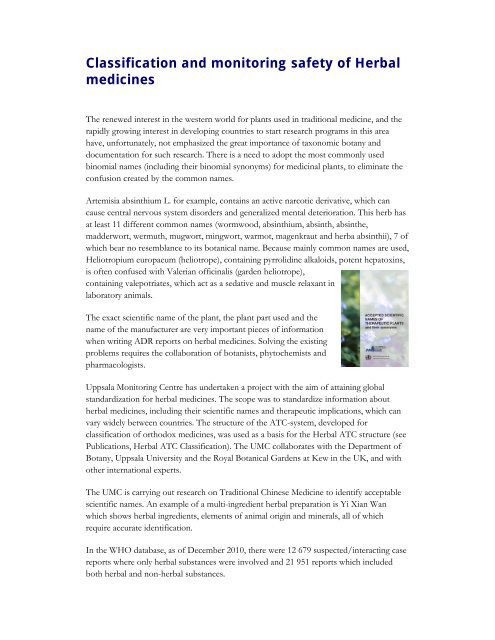Classification and monitoring safety of Herbal medicines - Uppsala ...
Classification and monitoring safety of Herbal medicines - Uppsala ...
Classification and monitoring safety of Herbal medicines - Uppsala ...
Create successful ePaper yourself
Turn your PDF publications into a flip-book with our unique Google optimized e-Paper software.
<strong>Classification</strong> <strong>and</strong> <strong>monitoring</strong> <strong>safety</strong> <strong>of</strong> <strong>Herbal</strong><br />
<strong>medicines</strong><br />
The renewed interest in the western world for plants used in traditional medicine, <strong>and</strong> the<br />
rapidly growing interest in developing countries to start research programs in this area<br />
have, unfortunately, not emphasized the great importance <strong>of</strong> taxonomic botany <strong>and</strong><br />
documentation for such research. There is a need to adopt the most commonly used<br />
binomial names (including their binomial synonyms) for medicinal plants, to eliminate the<br />
confusion created by the common names.<br />
Artemisia absinthium L. for example, contains an active narcotic derivative, which can<br />
cause central nervous system disorders <strong>and</strong> generalized mental deterioration. This herb has<br />
at least 11 different common names (wormwood, absinthium, absinth, absinthe,<br />
madderwort, wermuth, mugwort, mingwort, warmot, magenkraut <strong>and</strong> herba absinthii), 7 <strong>of</strong><br />
which bear no resemblance to its botanical name. Because mainly common names are used,<br />
Heliotropium europaeum (heliotrope), containing pyrrolidine alkaloids, potent hepatoxins,<br />
is <strong>of</strong>ten confused with Valerian <strong>of</strong>ficinalis (garden heliotrope),<br />
containing valepotriates, which act as a sedative <strong>and</strong> muscle relaxant in<br />
laboratory animals.<br />
The exact scientific name <strong>of</strong> the plant, the plant part used <strong>and</strong> the<br />
name <strong>of</strong> the manufacturer are very important pieces <strong>of</strong> information<br />
when writing ADR reports on herbal <strong>medicines</strong>. Solving the existing<br />
problems requires the collaboration <strong>of</strong> botanists, phytochemists <strong>and</strong><br />
pharmacologists.<br />
<strong>Uppsala</strong> Monitoring Centre has undertaken a project with the aim <strong>of</strong> attaining global<br />
st<strong>and</strong>ardization for herbal <strong>medicines</strong>. The scope was to st<strong>and</strong>ardize information about<br />
herbal <strong>medicines</strong>, including their scientific names <strong>and</strong> therapeutic implications, which can<br />
vary widely between countries. The structure <strong>of</strong> the ATC-system, developed for<br />
classification <strong>of</strong> orthodox <strong>medicines</strong>, was used as a basis for the <strong>Herbal</strong> ATC structure (see<br />
Publications, <strong>Herbal</strong> ATC <strong>Classification</strong>). The UMC collaborates with the Department <strong>of</strong><br />
Botany, <strong>Uppsala</strong> University <strong>and</strong> the Royal Botanical Gardens at Kew in the UK, <strong>and</strong> with<br />
other international experts.<br />
The UMC is carrying out research on Traditional Chinese Medicine to identify acceptable<br />
scientific names. An example <strong>of</strong> a multi-ingredient herbal preparation is Yi Xian Wan<br />
which shows herbal ingredients, elements <strong>of</strong> animal origin <strong>and</strong> minerals, all <strong>of</strong> which<br />
require accurate identification.<br />
In the WHO database, as <strong>of</strong> December 2010, there were 12 679 suspected/interacting case<br />
reports where only herbal substances were involved <strong>and</strong> 21 951 reports which included<br />
both herbal <strong>and</strong> non-herbal substances.
The most commonly reported critical terms for adverse drug reactions on herbal drugs are:<br />
Drug abuse 630<br />
Drug dependence 274<br />
Hepatitis 263<br />
Death 176<br />
Angioedema 169<br />
Coma 162<br />
Face oedema 160<br />
Anaphylactic shock 151<br />
Cardiac arrest 150<br />
Thrombocytopenia 118<br />
Anaphylactoid reaction 116<br />
Hallucination 115<br />
Asthma 111<br />
Respiratory depression 105<br />
Purpura 103<br />
Prothrombin decreased 92<br />
Aggressive reaction 89<br />
Epistaxis 89<br />
Hepatitis cholestatic 83<br />
Bronchospasm 79<br />
Circulatory failure 77<br />
Oedema mouth 77<br />
The most commonly reported herbals are:<br />
Cannabis sativa L. 1057<br />
Ginkgo biloba L. 960<br />
Hypericum perforatum L. 713<br />
<strong>Herbal</strong> pollen extract nos 690<br />
Senna alex<strong>and</strong>rina Mill. 435<br />
<strong>Herbal</strong> extract nos 331<br />
Cimicifuga racemosa (L.) Nutt. 312<br />
Echinacea purpurea (L.) Moench 302<br />
Plantago ovata Forssk. 287<br />
Serenoa repens (Bartram) Small 284<br />
Glycine max (L.) Merr. 276<br />
Oenothera biennis L. 274<br />
Vitis vinifera L. 206<br />
Mentha x piperita L. 205<br />
Citrus x paradisi Macfad. 195<br />
Valeriana <strong>of</strong>ficinalis L. 192<br />
Silybum marianum (L.) Gaertn. 174<br />
Viscum album L. 172<br />
Allium sativum L. 162<br />
Vitex agnus-castus L. 142<br />
Pelargonium reniforme root, Curtis 130<br />
Digitalis purpurea L. 129<br />
Ginseng NOS 125<br />
2/3<br />
March 2011
We need more reports - <strong>and</strong> more accurate information!<br />
Mohamed Farah, (mohmaed.farah@who-umc.org)<br />
Senior Specialist, Traditional Medicines<br />
<strong>Herbal</strong> ATC <strong>Classification</strong><br />
In 1998, De Smet proposed a system for ATC<br />
classification <strong>of</strong> herbal remedies which is fully<br />
compatible with the regular system. With a few<br />
modifications this system has now been adopted<br />
<strong>and</strong> is given in the guidelines.<br />
The <strong>Herbal</strong> ATC Index lists <strong>Herbal</strong> ATC (HATC) codes per substance, while the<br />
Guidelines for <strong>Herbal</strong> ATC <strong>Classification</strong> help to assign HATC codes to herbal remedies.<br />
In both the ATC <strong>and</strong> <strong>Herbal</strong> ATC systems remedies are divided into groups according to<br />
their therapeutic use. Whenever possible the level 1-4 codes in the herbal system are equal<br />
to the levels in the regular ATC system.<br />
So far we have been dealing with single herbs; now the UMC has begun assignment <strong>of</strong><br />
herbal ATC combinations, <strong>and</strong> it is hoped that the next issue will contain combination<br />
assignments.<br />
If you are interested in these publications, please contact info@who-umc.org
















